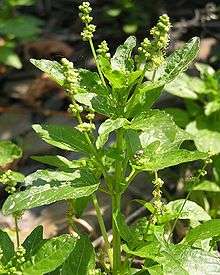Mercurialis annua
| annual mercury | |
|---|---|
 | |
| Mercurialis annua | |
| Scientific classification | |
| Kingdom: | Plantae |
| (unranked): | Angiosperms |
| (unranked): | Eudicots |
| (unranked): | Rosids |
| Order: | Malpighiales |
| Family: | Euphorbiaceae |
| Genus: | Mercurialis |
| Species: | M. annua |
| Binomial name | |
| Mercurialis annua L. | |
Mercurialis annua is a species of flowering plant in the spurge family known by the common name annual mercury. It is native to Europe, North Africa, and the Middle East[1][2] but it is known on many other continents as an introduced species.
Description
This is an annual herb growing 10 to 70 centimeters tall with oppositely arranged, stipulate oval leaves each a few centimeters long. The male flowers are borne in spikelike clusters sprouting from leaf axils, and female flowers grow at leaf axils in clusters of 2 or 3. The fruit is a bristly schizocarp 2 or 3 millimeters wide containing shiny, pitted seeds.[3][4]
The plant is mostly dioecious with male and female plants producing different types of inflorescence, Mercurialis annua can also be found to be monooecious or androdioecious, their complicated sexuality makes them the ideal model plant for studying sexual systems in plants.
Phytochemistry
Isorhamnetin-3-rutinoside-4′-glucoside, rutin, narcissin (Isorhamnetin 3-rutinoside), quercetin-3-(2G-glucosyl)-rutinoside and isorhamnetin-3-rutinoside-7-glucoside can be isolated from the methanolic extract of M. annua.[5]
Distribution and habitat
Mercurialis annua grows in many types of open habitat, including disturbed areas, from sea level to 1400 m.[3][4]
References
- ↑ Kew World Checklist of Selected Plant Families
- ↑ Altervista Flora Italiana, Mercorella comune, ortiga muerta, urtiga-morta, Einjähriges Bingelkraut, mercuriale annuelle, Annual Mercury, Mercurialis annua L. includes photos, drawings, and a European distribution map
- 1 2 Mayfield, Mark H.; Webster, Grady L. (2016). "Mercurialis annua". Jepson Flora Project (eds.) Jepson eFlora. Retrieved 14 January 2016.
- 1 2 Messina, Antonio (2014). "Mercurialis annua". Acta plantarum. Retrieved 14 January 2016.
- ↑ Phytochemical investigation on Mercurialis annua. R Aquino, I Behar, M D'agostino, F De Simone, O Schettino and C Pizza, doi:10.1016/0305-1978(87)90042-1